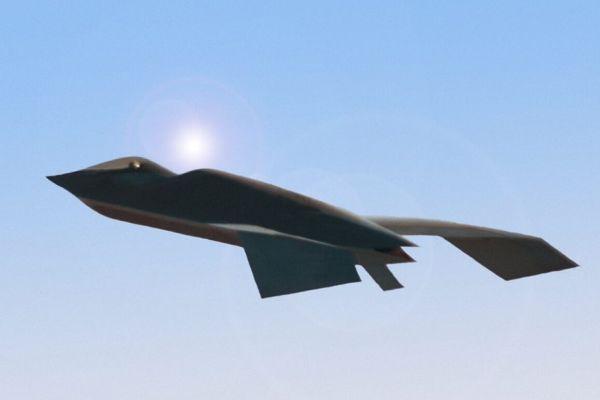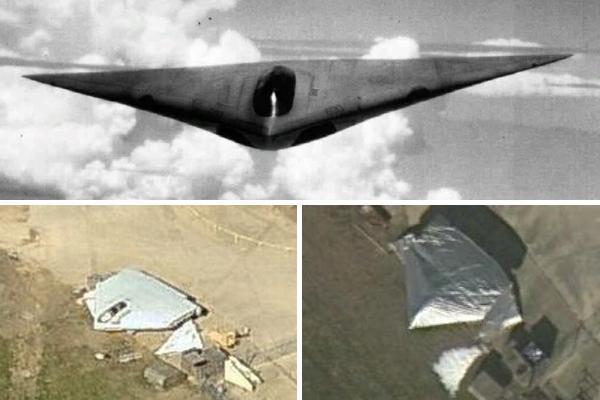
Top secret aircraft, even those that have been publicly disclosed, remain mysterious long after emerging from the black world. When – and if – secret planes are declassified, they’re treated differently from other military aircraft, and the specifics of their hardware may remain under wraps for decades. While some ultimately go to museums, others are placed into storage well away from prying eyes, awaiting a fate that may take years to arrive.
One such fate that has befallen crashed, retired or failed projects over the decades is burial. Aircraft have literally been dragged into deep pits miles from public land, often near the enigmatic Groom Lake test site in Nevada, famously known as Area 51. Not only does Groom serve as a testing ground for the U.S. government’s most advanced programmes, it also serves as the final resting place of many of its most secret aircraft. Some of these classified planes have never been publicly acknowledged.
Stealth Tombs at Tonopah

 (Image: Ikluft, cc-sa-3.0; US Air Force, public domain)
(Image: Ikluft, cc-sa-3.0; US Air Force, public domain)
Despite its retirement in 2008, the famous F-117 Nighthawk ‘Stealth Fighter’ has been spotted flying again over the Nellis Test Range in Nevada. It’s believed six airframes have been reactivated (four flying and two spares), perhaps as low observable test platforms for the next generation of stealthy U.S. aircraft. The rest of the fleet, meanwhile, rests at the shadowy Tonopah Test Range Airport near Area 51. Unlike other retired military aircraft that go to ‘the Boneyard’ at Davis-Monthan AFB in Arizona, stealth planes contain both toxic and sensitive technologies that make them harder to dispose of. One option, therefore, is burial.

 (Images: Paul Crickmore; US Air Force, public domain)
(Images: Paul Crickmore; US Air Force, public domain)
Four pre-production YF-117s are displayed at museums across the United States. A fifth was scrapped at Palmdale in April 2008 to test effective methods of destroying F-117 airframes. Meanwhile, rumours persist that the mothballed fleet is in the process of being dismantled and buried at Tonopah, miles from public land. According to AviationIntel.com: “Some have even said the jets will get their own headstones with their unique names inscribed on them for posterity sake, although USAF officials have never corroborated such a claim.” If true, it marks a strangely eerie departure from the traditional aircraft graveyard, though underscoring an ongoing respect for the deactivated F-117s.
Unmarked Aircraft Graves at Groom Lake
 (Images: US Air Force (1, 2, 3); US Military; US Navy; Geckow; public domain)
(Images: US Air Force (1, 2, 3); US Military; US Navy; Geckow; public domain)
The Nighthawks may be the latest airframes to be entombed in the desert, but the practice is hardly new. More than 12 aircraft wrecks are known to have been buried in unmarked graves at Groom Lake since the 1950s. These include four U-2 spy planes, several A-12s (predecessors of the SR-71 Blackbird), an F-101 chase plane (crashed 1965), a Russian-built MiG-23 that had come into U.S. possession (crashed 1984) and two Lockheed Have Blue proof-of-concept aircraft that crashed near Area 51 while demonstrating technology for the F-117 in the late 1970s.

 (Images: DARPA/US Air Force; U.S. Government via Lockheed, public domain)
(Images: DARPA/US Air Force; U.S. Government via Lockheed, public domain)
When they crashed, these aircraft were still highly classified. Lockheed engineers have since searched fruitlessly for one of the Have Blue aircraft (above), which was said to be relatively intact. But the search was terminated when diggers allegedly began unearthing other classified projects. The Have Blue’s final resting place, thought to be south of the main hangar complex, has now reportedly been paved over.
 (Image: Google Earth; Have Blue burial site rumoured to be in above vicinity)
(Image: Google Earth; Have Blue burial site rumoured to be in above vicinity)
Mystery Aircraft Graves at Area 51
Strong evidence also suggests that a number of as yet unacknowledged aircraft lie buried near the dry lake at Area 51. One former Groom Lake employee, speaking in 2001 on condition of anonymity, said he witnessed an earth-mover spend a day excavating a burial site in 1982.
He said the wreck of a top secret aircraft had been stored for months in the ‘Scoot-N-Hide’ shed, a hangar near the taxiway designed to swiftly hide planes from orbiting satellites. According to the witness: “They put it on a flatbed truck and put it in a hangar. Then one day they scraped it off the flatbed into the hole and buried it,” he said. “They attached a cable to the aircraft and just pulled it off. The thing was shattered like an egg.”
Dyson’s Dock and the Ones that Got Away
 (Image: Google Earth)
(Image: Google Earth)
In addition to burial sites, there’s another top secret facility at Groom Lake for mothballed projects. Known as Dyson’s Dock, it is said to be housed in the lower bay of Hangar 18 and may be a sort of classified museum, where base workers can view retired aircraft that have not been publicly unveiled. But even these individuals aren’t, it has been claimed, cleared to view every craft in the dock.
 (Images: top, bottom, U.S. Air Force, public domain)
(Images: top, bottom, U.S. Air Force, public domain)
Two technology demonstrators - Northrop Tacit Blue (above) and Boeing Bird of Prey (below) – were stored in Dyson’s Dock for several years. It’s thought that Tacit Blue was due to be buried at Groom, only to be saved through the efforts of those involved in its design and testing more than a decade prior. Both former black projects are now on display at the National Museum of the USAF in Dayton, Ohio.
 (Image: U.S. Federal Government via Dreamland Resort)
(Image: U.S. Federal Government via Dreamland Resort)
But what else sits quietly in Dyson’s Dock, or lies buried in the earth? The answer is that we really don’t know, and those who do aren’t talking. There are some tantalising clues, from rumoured projects to credible yet unconfirmed sightings of mystery aircraft.
Mystery Aircraft
In August 1989 engineer Chris Gibson, a trained aircraft recognition expert with the Royal Observer Corps, witnessed a mysterious, highly swept triangle-shaped aircraft while working on the oil rig GSF Galveston Key in the North Sea. The aircraft was accompanied by two F-111 bombers and appeared to be refueling from a KC-135 Stratotanker in an area of sky designated for such activity.
 (Images: USAF (via Stratosphere Models); NASA; public domain)
(Images: USAF (via Stratosphere Models); NASA; public domain)
In 2012, the identity of Gibson’s ‘North Sea sighting’ remains a mystery, although the aircraft’s plan-form was strikingly similar to that of a lifting body, such as the X-24B, and the results of research carried out by the Air Force Flight Dynamics Laboratory (FDL-5 mock-up above left). Interestingly, a follow-on project called the X-24C was floated in the 1970s, but later cancelled. Some say it may have continued as a black project. Others dispute this idea.
 (Images: NASA, public domain; inset: Aviation Week via Wikipedia)
(Images: NASA, public domain; inset: Aviation Week via Wikipedia)
Meanwhile, a 2006 Aviation Week article drew attention to a rumoured spaceplane project called Blackstar. The two-stage-to-orbit system allegedly included a ‘mothership’ called the SR-3 and a smaller spaceplane dubbed the XOV (Experimental Orbital Vehicle). The SR-3 was said to resemble the cancelled 1960s North American XB-70 Valkyrie, with sightings of a similar aircraft throughout the 1990s. A craft fitting the description of the XOV was also spotted by personnel at Kadena AFB on Okinawa following an apparent emergency landing. The project was supposedly mothballed around 2006, with Dyson’s Dock its likely resting place. Critics, however, dispute these claims.

 (Images: Google Earth; USAF, public domain)
(Images: Google Earth; USAF, public domain)
There have been many strange sightings over the years of mystery aircraft both in the U.S. and abroad. One compelling incident took place in 1994 at the secretive Boscombe Down airfield in the UK. The event was said to involve a top secret U.S. aircraft that was forced to abort takeoff due to a nose wheel failure. Amid tight security, the mystery plane, half covered by a tarpaulin in a bid to mask its shape, was loaded onto a C-5 Galaxy and transported back to the U.S. – reportedly bound for Plant 42 at Palmdale, where many classified projects have originated from over the years.
Buried in Unmarked Graves?
 (Image: Doc Searls, cc-3.0)
(Image: Doc Searls, cc-3.0)
Whether some of these sightings are connected, and indeed whether these craft even exist, is a matter of speculation. Either way, there seems little doubt that over the years myriad secret aircraft, some of them yet to be publicly acknowledged, have been tested at Groom Lake and buried within the test ranges of the Nevada Desert.
 (Image: Geckow, public domain)
(Image: Geckow, public domain)
Others remain stored in the enigmatic Dyson’s Dock. But here, space is at a premium, and as newer projects are retired or mothballed, others must be cleared out to make room. Northrop’s Tacit Blue was a lucky survivor, but how many other cutting-edge engineering marvels have been towed from the Dock and dragged unceremoniously into anonymous pits, adding to the unmarked graves that punctuate this vast and inaccessible landscape?
Respected aviation archaeologist and historian Peter Merlin told the Las Vegas Review Journal that the combined value of the buried craft could total between $600 million and $1 billion – and that was in 2001.
 (Image: Seth Kettleman)
(Image: Seth Kettleman)
Every now and then, though, clues do come to light, and in unlikely places. This time last year, the canopy of a shadowy stealth aircraft (intended for service with the U.S. Navy but controversially cancelled before going into full scale development) appeared on eBay - read more about the A-12 Avenger II canopy. As for the others, they say the truth is out there. But we may never find it.
If you enjoyed this article, why not subscribe to our RSS feed, connect with us on Facebook and Twitter or subscribe by email.




